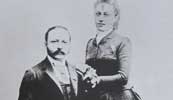Cesar Ritz.
A PARIS EDITIONS JULES TALLANDIER 17, RUE REMY-DUMONCEL.
FIRST EDITION. (copyright 1948) 1fep. Half Title with a dedication – “A Monsieur A. Kienberger Souvenir du Cinqn au tenaire en Jenuoiguage de Symphathie – Marie Louise Ritz. June 1948. (apologies for possible mistakes. Madame Ritz’s writing is hard to decipher). [2] Frontispiece photograph of Cesar Ritz. [1] 1p Dedication to Colonel Hans Pfyffer d’ Altishofon. [1] 1p Avertissement. [1] 11-285(1) 1fep. Numerous early full-page b/w photographs. Pages untrimmed and some uncut. Cream paper covers, with a picture of the Paris Ritz Hotel on the front. On the back a printers device.
- This is the story of a great Hotelier written by his dedicated wife Marie Louise Ritz. She was also a very experienced Hotelier in her own right, taking over the running of the Ritz Hotels after Cesar’s well documented breakdown. Even tho’ the last years of Ritz’s life were sad, he made a fundamental and profound change to Hotels. His innovations are little realised, even by those at the top of the industry today. What Cesar Ritz consciously set out to achieve was design hotels from the ground up for the benefit of women only. Using all the new inventions like electricity, hot water in bathrooms in each room, beautiful feminine furnishings and décor and above all fine food. To that end he teamed up with his old colleague & collaborator Auguste Escoffier, the great Chef. Escoffier joined Ritz at his first venture in England in April 1890, at the newly built Savoy Hotel. Escoffier had initially refused to join Ritz in London, but after a visit, he was overwhelmed by the innovative beauty of the new hotel and took charge of the kitchens. This was the final arrangement that assured the Savoy's success. Ritz very astutely understood that if women were enticed thro the doors of his well thought out establishments, and above all felt comfortable there, their men would follow. This proved to be a huge success, causing an industry sea-change, highlighting the poor way hotels had operated up until then, having always been designed solely for the use of men. Women had not frequented these places since their inception centuries before. Now Ritz’s hotels had a huge customer increase, targeting approximately 50% of the population that had never eaten out before. Not only that, the occupancy of hotel rooms increased dramatically. In the book Madame Ritz tells of his triumphs with understandable pride, filling her pages with the names of royalty, statesmen, famous beauties and those who follow them. Discretion prevents her from making her book more than a collection of society-gossip paragraphs, but the collection covers a period of great social change. Ritz was successful because he anticipated most of those changes; many distinguished people saw their first real bathroom in a Ritz hotel. Marie-Louise Ritz, nee Beck, was born in Alsace on the 29th October 1867, the daughter of a hotelier family. Her mother owned a small hotel in Menton. On 16th January 1888, 38 year old Caesar Ritz married the well educated and multi-lingual young lady who was only 21 years old. Before the marriage there had been a long period of friendship and companionship. Their wedding took place in Cannes. Marie-Louise Ritz gave birth to two sons: Charles and René Ritz. Cesar was the undoubted star of the hotel industry, and was managing up to ten hotels at the zenith of his accomplishments. Shortly after that he began to suffer from breakdowns and depression. In 1902 his illness forced him to pass over his business to his wife Marie-Louise Ritz. She carried on her husband's hotel empire as first hotel manageress in the world. Caesar Ritz retreated to his beloved home village Niederwald, in Central Switzerland, for the last 16 years. He died in a clinic on the 25th October 1918. Marie-Louise had him buried in the graveyard of Père Lachaisein, Paris. On Saturday 14th January, 1961, a special train from Paris took the small coffin of the deceased Marie-Louise Ritz, and in a larger one, containing the disinterred bodies of Caesar Ritz and his son René Ritz. The two coffins were laid out in the birth house of Caesar on the outskirts of the little village. The village people walked by loyally until Monday and prayed for their great son and his family. On Monday morning the two coffins were then laid out on the village square next to the Ritz Memorial Well. On the same day a special train brought the mourners. At the head of the group was Cesar & Louise’s first-born son, 70 year old Charles Ritz, the owner of the Hotel Ritz in Paris. The whole village of Niederwald took part in the burial with all of the older generation who knew the Ritz family personally. The press of the world were also present. This is a story of a couple who, thro’ very hard work, vast experience, attention to the finest details, achieved a lasting reputation for the highest quality and service that even earned them lasting affection and gratitude from not only the elite of European society, but all the people that benefited from their enterprise.






click on image to enlarge

Modern category
ref number:
11229